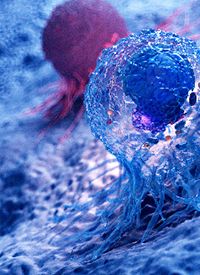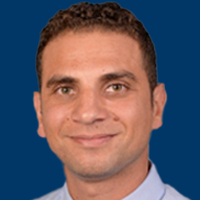AUTO4 CAR T-Cell Therapy Is Well Tolerated in R/R TRBC1+ Peripheral T-Cell Lymphoma
The CAR T-cell therapy AUTO4 was not associated with dose-limiting toxicities and led to early indications of efficacy in patients with relapsed/refractory TRBC1-positive peripheral T-cell lymphoma.

The CAR T-cell therapy AUTO4 was not associated with dose-limiting toxicities (DLTs) and led to early indications of efficacy in patients with relapsed/refractory TRBC1-positive peripheral T-cell lymphoma (PTCL), according to findings from the first-in-human AUTO4-TL1 trial (NCT03590574) that were presented at the 17th Annual International Conference on Malignant Lymphoma.1
In all patients infused with the product (n = 13), any-grade and grade 3 or higher treatment-emergent adverse effects (TEAEs) were observed in 92.3% (n = 12) of patients each. TEAEs included neutropenia/decreased neutrophil counts (grade ≥ 3, 69%), infections and infestations (any-grade, 53.8%; grade ≥3, 7.7%), serious TEAEs (any-grade, 38.5%; grade ≥3, 30.8%), and cytokine release syndrome (any-grade, 53.8%; grade ≥3, 7.7%). Notably, no immune effector cell–associated neurotoxicity syndrome of any grade was observed.
Previously, a prospective study (NCT01142674) showed that 68% of patients with PTCL relapsed (21%) or were refractory (47%) after first-line treatment, with a median progression-free survival (PFS) of 8 months and a median overall survival (OS) of 5.8 months.2
“To date, [patients with] PTCL have not benefitted from immunotherapy, pan T-cell depletion is toxic, and there are few tumor-specific antigen targets in PTCL,” lead study author Kate Cwynarski, MD, of the Department of Hematology at University College London Hospital in the United Kingdom, said in a presentation of the AUTO4-TL1 data.1
PTCL is a clonal disease that expresses either TRBC1 or TRBC2. Normal T-cell populations contain both TRBC1- and TRBC2-positive cells. However, T-cell cancers affect only 1 type of cell. AUTO4 selectively targets TRBC1 over TRBC2, allowing for elimination of the T-cell malignancy in TRBC1-positive cells and simultaneous preservation of enough normal TRBC2-positive T cells to maintain immunity.3
AUTO4-TL1 consented patients in 2 parts.1 In part A, patients’ archived lymphoma tissue underwent next-generation sequencing screening for TRBC1 or TRBC2. In part B, patients with TRBC1-positive tumors underwent study screening. Eligible patients included those age 18 years or older with confirmed TRBC1-positive relapsed/refractory PTCL–not otherwise specified (PTCL-NOS), angioimmunoblastic T-cell lymphoma (AITL), or anaplastic large cell lymphoma (ALCL) who have received at least 1 prior line of therapy. Patients were excluded if they had active or prior central nervous system involvement or if they had received prior allogeneic stem cell transplant.
A total of 122 patients with lymphoma have been screened, and 34% (n = 39) were found to have TRBC1-positive disease. Of these patients, 20 did not enroll in the trial because of death (n = 7), screening failure (n = 6), PD (n = 2), and other reasons (n = 5). Nineteen patients have enrolled in the trial so far, of whom 13 have been treated. Of the 6 enrolled patients who were not treated, 2 are pending AUTO4 infusion, and 4 discontinued the trial before AUTO4 infusion, 1 who died and 3 who discontinued because of other reasons.
AUTO4-TL1 is evaluating 2 manufacturing processes. In process A, frozen leukapheresate underwent TRBC1-positive cell depletion followed by T-cell activation, T-cell transduction, and CAR-positive T-cell expansion based on viable cell concentration to produce cryopreserved CAR-positive T cells. In process B, frozen or fresh leukapheresate will undergo TRBC1-positive cell depletion followed by CD4/8-positive cell selection, T-cell activation, T-cell transduction, and CAR-positive T-cell expansion based on viable cell concentration to produce cryopreserved CAR-positive T cells.
In the phase 1 dose escalation portion of this trial, patients received a pre-conditioning regimen of fludarabine at 30 mg/m2 intravenously on days –6 through –3 and cyclophosphamide at 500 mg/m2 on days –6 and –5. Process A dosed 10 patients, with a median follow-up of 13.8 months. Cohort 1 consisted of 3 patients who received AUTO4 at 25 x 106 CAR T cells. With no DLTs, cohort 2, which consisted of 2 patients, received AUTO4 at 75 x 106 CAR T cells. Cohort 2 had no DLTs, so cohort 3, which consisted of 1 patient, received AUTO4 at 225 x 106 CAR T cells, with no DLTs. Cohort 4, which consisted of 4 patients, received AUTO4 at 450 x 106 CAR T cells.
Process B has dosed 3 patients so far, 1 of whom was enrolled in cohort 3 and 2 of whom were enrolled in cohort 4, all with a median follow-up of less than 3 months.
Safety is the primary end point of this trial, with overall response rate, duration of response, PFS, and OS as key secondary end points.
At a data cutoff of April 28, 2023, across the populations in processes A and B (n = 13), the median age was 57 years (range, 34-72). In total, 31% (n = 4) and 69% (n = 9) of patients had an ECOG performance score of 0 and 1, respectively. Patients had a median of 2 (range, 1-5) prior lines of therapy, and 15% (n = 2) and 85% (n = 11) of patients had stage I/II and III/IV lymphoma at screening, respectively. In total, 54% (n = 7), 31% (n = 4), and 15% (n = 2) of patients had PTCL-NOS, AITL, and ALK-negative ALCL, respectively. Overall, 23% (n = 3) of patients had received prior autologous stem cell transplant, and 77% (n = 10) of patients had received bridging therapy. Additionally, 69% (n = 9) of patients had CD30-positive T-cell non-Hodgkin lymphoma, of whom 5 received brentuximab vedotin (Adcetris) as a prior line of therapy, 2 received brentuximab vedotin as bridging therapy, and 2 had ALCL.
In the process A population, 2 patients had detectable AUTO4 CARs in the blood, of whom 1 experienced peak expansion at day 13 and persistence until day 120, the latest day they were tested, and 1 had CARs detectable in the blood 1 hour and 10 minutes after infusion. Five patients had evaluable lymph node formalin fixed paraffin embedded (FFPE) samples, all of which showed CAR presence by digital droplet polymerase chain reaction (ddPCR). Three patients from cohort 1, whose FFPE samples were collected on days 75, 11, and 7 post-infusion, respectively, had AUTO4 CARs in their lymph nodes at 19,695 VCN/ug DNA, 520 VCN/ug DNA, and 4,141 VCN/ug DNA, respectively, per ddPCR.
“We haven’t detected CAR in the majority of our patients’ [blood], but we have in the lymph nodes,” Cwynarski noted during the presentation. “The question is: Is this due to fast homing of the CARs to the tumor sites? We have ongoing work to assess persistence as well as the potential of T-cell fratricide.”
Of the patients enrolled in process A, 4 achieved a complete response (CR), 3 of whom received AUTO4 at the highest dose and 1 of whom received the product at the cohort 1 dose. Of these patients, 2 had a best Deauville score of 1, and 1 each had a best Deauville score of 2 and 3. Two patients achieved a partial response (PR), 1 from cohort 2 with a best Deauville score of 4 and 1 from cohort 4 with a best Deauville score of 4. Two patients, both with a best Deauville score of 5 and 1 each from cohorts 1 and 2, achieved a best response of progressive disease (PD). One patient with a best Deauville score of 5 who received AUTO4 at the cohort 1 dose was not evaluable.
Of the process A population, at a median follow-up of 13.8 months, 80% of patients were alive, and all 4 patients who received the highest dose of AUTO4 achieved a response. Two patients from this cohort, both with AITL, remained in CR at 15 and 18 months post-infusion with the highest AUTO4 dose. One patient each with PTCL-NOS achieved a CR followed by PD and a PR followed by PD. The patient in cohort 3, who had ALCL, achieved a CR followed by PD. The patients in cohort 2, both with PTCL-NOS, achieved a PR followed by PD and PD followed by death from an underlying cancer, respectively. In cohort 1, 2 patients with AITL achieved a CR followed by PD and death from an underlying cancer and a best response of PD, respectively, and 1 patient with PTCL-NOS achieved a best response of PD.
During the presentation, Cwynarski shared a case study of a 63-year-old male with AITL who was enrolled in cohort 4 of process A after progressing on prior CHOP (cyclophosphamide, doxorubicin, vincristine, and prednisone), ICE (ifosfamide, carboplatin, and etoposide phosphate), and duvelisib (Copiktra). At month 1 post–AUTO4 infusion, this patient had a Deauville score of 2, and at month 15 post-infusion, they had a Deauville score of 1.
In another case study, a 61-year-old male with AITL who had previously achieved a 12-month CR with CHOEP (cyclophosphamide, doxorubicin, etoposide, vincristine, and prednisone) and progressed on subsequent DHAP (dexamethasone, cytarabine, and cisplatin) achieved a Deauville score of 2 1 month post–AUTO4 infusion and a Deauville score of 1 at 18 months post-infusion.
“This study is ongoing, with additional patients due to be treated in the dose escalation using manufacturing process B to define the phase 2 dose,” Cwynarski concluded.
Disclosures: Dr Cwynarski reports consulting/advisory roles with Roche, Takeda, Celgene, Atara, Gilead, Kite, Janssen, Incyte, and AbbVie; speaker’s bureau roles with Roche, Takeda, Kite, Gilead, and Incyte; and conferences/travel support from Roche, Takeda, KITE, Janssen, and BMS.
References
- Cwynarski K, Iacoboni G, Tholuoili E, et al. First in human study of AUTO4, a TRBC1-targeting CAR T cell therapy in relapsed/refractory TRBC1-positive peripheral T-cell lymphoma. Presented at: 17thInternational Conference on Malignant Lymphoma; June 13-17, 2023. Lugano, Switzerland. Abstract 044.
- Bellei M, Foss FM, Shustov AR, et al. The outcome of peripheral T-cell lymphoma patients failing first-line therapy: a report from the prospective, International T-Cell Project. Haematologica. 2018;103(7):1191-1197. doi:10.3324/haematol.2017.186577
- Maciocia PM, Wawrzyniecka PA, Philip B, et al. Targeting the T cell receptor β–chain constant region for immunotherapy of T cell malignancies. Nat Med. 2017;23(12):1416-1423. doi:10.1038/nm.4444



